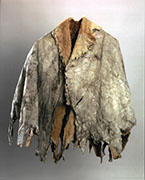Technologies and Techniques
 booka
booka
 dowak
dowak
 gidjee
gidjee
 kodj
kodj
 kyli
kyli
 miro
miro
 wonna
wonna
 woonda
woonda
Click the sound files to hear the Nyungar words on this page.
Nyungar developed many types of technologies and techniques for life on Derbal Nara. Possum hair was used for many ornamental reasons. Kangaroo skin was worn as a Booka or cloak, and the bones sharpened for use as needles.
Tools were also made from a variety of woods and rocks. These included: Gidji (Spear), Kyli (Boomerang), Miro (Spear thrower), Dowak (short heavy stick), used for knocking down birds, Woonda (shield), Wonna (women’s digging stick).
Many of the stones also were fashioned into tools such as spearheads, scrapers and grinding stones. The kodj (stone axe) was made by gluing scrapers (often made from the rock, Dolerite) to a wooden handle with an amalgam of ash, kangaroo excrement and Balga resin. The scrapers were positioned so that one side was sharp for cutting, the other blunt for hammering and pounding. Kodj were also used to make hand and footholds in tree trunks to aid in the search for wild honey, birds’ eggs and possums.2
We used to put the net out and get mullets and so… we were just practising our culture because in the early days we used Dodder… and Dodder is a mat that grows over a Paperbark and it’s just like a net, and they’d wrap it up and put it across the river and they’d drive the fish into this Dodder and it’s a Dodder that you’d find round the Paperbarks.3
There were other means of catching too. Collard and Palmer report that:
Sometimes the Nyungar just used their bare hands to catch fish. Nyungar men, Yok (women) and kullungars (children) worked together to catch djildjit (fish)4 this way. Nyungar yok drove them into the shallow water. Two or three women would watch the shoal from the beach, keeping opposite to it, while twenty or thirty men and women took tree boughs and formed a semi-circle out in the shallow bay. Gradually closing in, they would hedge the djildjit up in a small space close to the shore, while a few others got into the water in order to throw the fish out with their hands.5
Yok (Nyungar women) sometimes cooked the djildjit by simply broiling them on the fire. At other times they chose a thick, tender piece of paper bark, tore it into an oblong shape and wrapped the djildjit in it. Strings (probably from the stringy bark or grass) were tightly wound around the bark that contained the djildjit, and then slowly baked in the hot sand, covered with ashes. This process was called ‘tying up cooking’.6 When the food was cooked the bark was peeled back and used as a serving dish. Apparently cooking djildjit in this way produced a succulent juice and gravy.7 (Précis from Collard & Palmer1)
Heritage sites with large numbers of tools exist, and these bear witness to the Nyungar lifestyle in Beeliar country.
Prior to European settlement in 1829, Cockburn had a large Aboriginal presence. Archaeologists have found campsites near North Lake and Bibra Lake. Artefacts and rock engravings found in Cockburn also reflect use of the land. Chert stone artefacts indicate continual use for at least 2,000 years.
Coolbellup is associated with the mythology of the female Waugal. A swampy area, now called Horse Paddock Swamp, is associated with the ‘Firestick Story’, a myth of how fire was stolen from the moon and bought to the Beeliar people. Some nearby high ground was used for burials.
Semi-permanent campsites were established around both lakes. The elderly remained near the lakes throughout the year, whilst the remainder dispersed inland in winter. The lakes provided turtle, waterfowl and typha reeds. The lakes were also a site for ceremonial activities.
When the colony was settled, the Whadjuk leader for the Beeliar territory was Midgegooroo. He and his son Yagan were early casualties of the conflict with the colonists.8
References
1. Collard, L. & Palmer, D. Nidja Goordandalup! Noonookurt Nyinning Nyungar Boodjar: A Nyungar Interpretive History of the Use of Boodjar (Country) in the Vicinity of the University of Western Australia. 1998. Aboriginal and Islander Studies, Murdoch University
2. http://museum.wa.gov.au/research/collections/anthropology-and-archaeology/aboriginal-cultures-collection/kodj-axe
3. Trevor Walley, unpublished oral interview, held by Laura Stocker, Curtin University and Len Collard, UWA.
4. Moore, G. F. (1884). Diary of Ten Years of Eventful Life of an Early Settler in Western Australia. Perth: University of Western Australia, p. 55-56
6. Grey, G. (1841). Expeditions in Western Australia 1837 - 1839. Perth: Hesperian, p. 275-6
7. Hallam, S.J. (1987). Aboriginal resource usage along the Swan River. In John, J. (Ed.). The Swan River Estuary: Ecology and Management. Bentley: Curtin University, p. 27
8. City of Cockburn, History of Cockburn Thematic Framework, 2.








